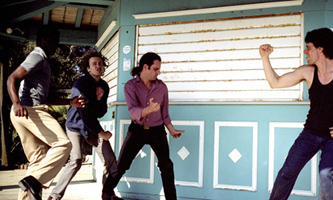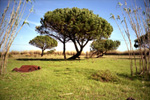1st May - 22 June 2008
Alexia Walther & Maxime Matray
L’ÉTÉ
Show opening Wednesday 30 April starting at 6 pm
Show runs from 1st May to 22 June 2008
Tuesday- Sunday, noon to 6 pm, free entry
(27 - 29 May : exhibitions specially closing at 7 pm)
*Tuesday 27 May 7 pm
"Show must go on" Free showing
Screenings of Miranda Pennell's and Alexia Walther's videos *
 Alexia Walther, Twist, 2006, 11 min.Alexia Walther was born in 1974 in Geneva. She currently lives and works in Paris. Since graduating in 1999 from Geneva's Advanced School of Visual Arts (ESAV, Ecole supérieure d'Art visuel) in mixed media, she has taken part in numerous shows.
Alexia Walther, Twist, 2006, 11 min.Alexia Walther was born in 1974 in Geneva. She currently lives and works in Paris. Since graduating in 1999 from Geneva's Advanced School of Visual Arts (ESAV, Ecole supérieure d'Art visuel) in mixed media, she has taken part in numerous shows.
Maxime Matray was born in 1973 in Paris. A visual artist and author, he graduated in 1995 from the Villa Arson's International Pilot School of Art and Research (EPIAR, Ecole Pilote Internationale d'Art et de Recherche) in Nice.
The two artists' collaboration began with the short film Twist (written and directed by Alexia Walther; music by Maxime Matray), which won 12th Biennial of Moving Images Prize in 2008. Their film draws a parallel between an episode of Julius Caesar's Gallic War and a choreographed summary of the twist's history. The film depicts two defeats, a historic one and a more symbolic one, the defeat of a hypothetical liberation of the body through dance, namely the twist. The word, then the dance, or how the word is made flesh.
The story of the twist is treated linearly and tries to illustrate this dance step as a social phenomenon, representative perhaps of the hedonistic society as Pasolini defined it. Born in the 1960s in the United States, the twist seemed to hold out the promise of bodily liberation, a more laid-back, relaxed way of dancing aimed at a younger audience. Yet it only really existed for five years and was quickly snapped up by the world of business and commerce, winning over ever-larger audiences. The dance in the film, choreographed by Foofwa d'Imobilité and the dancer Filibert Tologo, is transformed, illustrating its own history.
Since then Walther and Matray have written and codirected another short film, L'Élan, which is currently in postproduction. Shot in the south of France and situated in the present, the film depicts two men who are going to fight a duel. More than the duel itself, the film focuses on what the upcoming combat involves in terms of movements and contradictory sentiments, and what kinds of strategies the characters develop to preserve their initial impulse. What becomes of the fervor of honor and the desire for bravery when faced with waiting, the unknown, fear?
 Alexia Walther and Maxime Matray, L'Élan, 2008, 15 min.Thanks to these ready-made expressions, the protagonists seem to protect themselves from the weakness threatening them and maintain their place in social representation. However, the closer the combat draws, the rarer their words become. A song without words precedes the duel itself. Finally, on the field of honor at the tale's climax, every sound heard is a synthetic one.
Alexia Walther and Maxime Matray, L'Élan, 2008, 15 min.Thanks to these ready-made expressions, the protagonists seem to protect themselves from the weakness threatening them and maintain their place in social representation. However, the closer the combat draws, the rarer their words become. A song without words precedes the duel itself. Finally, on the field of honor at the tale's climax, every sound heard is a synthetic one.
The motif of dueling has an important place in narrative, whether literature or film. By shifting this theme to our day and age, Walther and Matray evoke the contemporary question of heroism. It is a dual and contradictory tension produced by a society that encourages self-invention and competition while commanding people to be sincere and spontaneous in their choices and acts. The film is also concerned with observing human relations that are increasingly refereed and mass-mediated through technology.
The piece presents an armed duel. The pistol mechanizes a practice that is a question of luck, contingencies, the weather, unlike a duel with swords and the skill it demanded. By setting up new rituals, this minor historical fact marks a social transformation at the end of the 19th century. Subjects inspired by social mores that are a break with the past or at odds with one's own time, as well as echoes of structures and references from the world of literature strictly speaking—these are some of the elements that characterize Walther's work.
L'Été, a brand-new piece coproduced by the Center for Contemporary Images, once again the result of the two artists' collaboration, will be featured in preview screenings at the Center's Saint-Gervais venue. In the film two gardeners prepare a ground close to the beach for the tourist season. The scene/motif, each time it is shown, is a bit different. Edited to run end to end, the sequences do not actually form a loop then. The characters, like actors, are caught up in a repetitive activity; they tell the story of a dream that comes up again and again and becomes a dream commentary on their own working conditions. The motif of repetition, which leaches out the reality of what is repeated, exists at every level.
Viewers find themselves also facing a similar experience, mirroring in miniature the characters' situation, that is, they are subject to a narrative that is repeated almost identically. The film inevitably evokes the gothic genre in literature, which is founded on the reader's hesitation between a rational and supernatural interpretation of a tale since the text allows for both. Readers, like the characters, see themselves sucked into an alienating spiral that originates in these flaws in reality. Are viewers of Walther and Matray's film watching a collection of rushes featuring actors rehearsing a scene before performing it? Or are they looking at the ironic retelling of a dream?
 Alexia Walther and Maxime Matray, L'Été, 2008
Alexia Walther and Maxime Matray, L'Été, 2008
